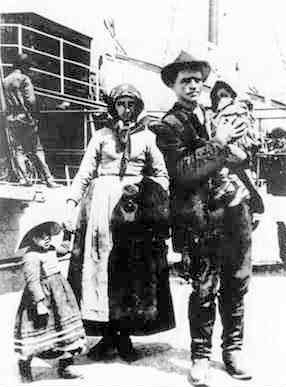ITALIAN GROUP Moschetta Martina, Gammino Francesco, Rella Raffaella
MIGRATION ABROAD AFTER THE WAR
At the end of the Second World War, it exploded with virulence the phenomenon of immigration. Germany, that had lost the war, achieved an industrial growth in the 60’s.But, because of lack of manpower, in Italy it was generated the phenomenon of emigration. In Italy, in fact, the war had increased the poverty and decelerated industry mostly in the south. As a result of this, a part the population moved to Germany in search for luck. Other Nations where migrants moved to were: France, also a country with a big economic expansion, Belgium, Switzerland and Austria.
IMMIGRATION IN BELGIUM
Between 1946 and 1956 more than 140 thousand Italians crossed the Alps for going to work in coal mines of Vallonia. In fact an agreement was signed between Italy and Belgium that included an exchange: Italy had to send 2000 men a week in Belgium and Bruxelles undertook to provide to Rome 200 kilograms of coal every day for every single miner. Everything ended with the tragedy of Marcienelle in 1956.
IMMIGRATION IN GERMANY
In about 20 years there have been about 4 million the departures with a return of 3million and a half. German policy choice, in fact, considered immigration a transitional phenomenon, a sheer exchange of work-force, determined by law in time and in ways: rotary model or Gastarbeiter (guest worker). In the Germany of the 50’s, Italians could enter in the country with an annual or seasonal contract, they could bring with them their families if they proved to have a suitable house. They were accommodated in first reception structures like barracks or villages, built far from the town centres.Italians that entered into Germany for a job had to obtain a renewal of the labor contract, which still was "provisional", because German law didn't allow a possible long stay.
The integration with the culture and the local population was slow and difficult. In December 1955, Italy signed with the German government a bilateral agreement the give formally the root to the migration of labor forces from Italy to Germany.

THE CULTURAL MIXINGS AND THE FIRST INTEGRATIONS (GERMANY)
The cultural and social shuffles that mold today’s Europe, started in this period. In fact, a part of Italians that left their country to seek employment in foreign countries, were actually integrated in the arrival places.
Nevertheless, integration of Italians in Germany was not totally favored because of bilateral agreements, which included, as a kind of today's residence permits, a 12-months’ contract, renewable according to the requirements of the employer. A feature of the recruitment policy of the German government was called ‘Rotationsprinzip’, the tenet of rotation. Germany, which was not considered an immigration country, counted on a short-term stay of immigrants who were supposed to return home after a few years. This represented for Germany less investment and social costs (for example for kindergartens, school facilities, social housing, and so on); it would have been different if the migrants had remained for a long time and had formed a family in Germany. According to the “rotations-principles”, the whelfare costs had to be sustained by the countries of origin of migrants, where their families often resided. So migrants departed to Germany with the idea of staying for a short time, working hard, leaving family, and returning after two years.
IMPORTANT BETWEEN 1945-55 WAS ALSO THE TRANSOCEANIC IMMIGRATION AND ESPECIALLY IN AMERICA.
Migration in America was huge in the second half of the century. The countries where most Italians migrants directed were: the United States of America, Brazil and Argentina.
LINK: https://it.wikipedia.org/wiki/Emigrazione_italiana
file:///C:/Users/utente/Downloads/84157%20(1).pdf
http://www.istitutosup-gavirate.it/studenti/immigrazione/geografia.html
